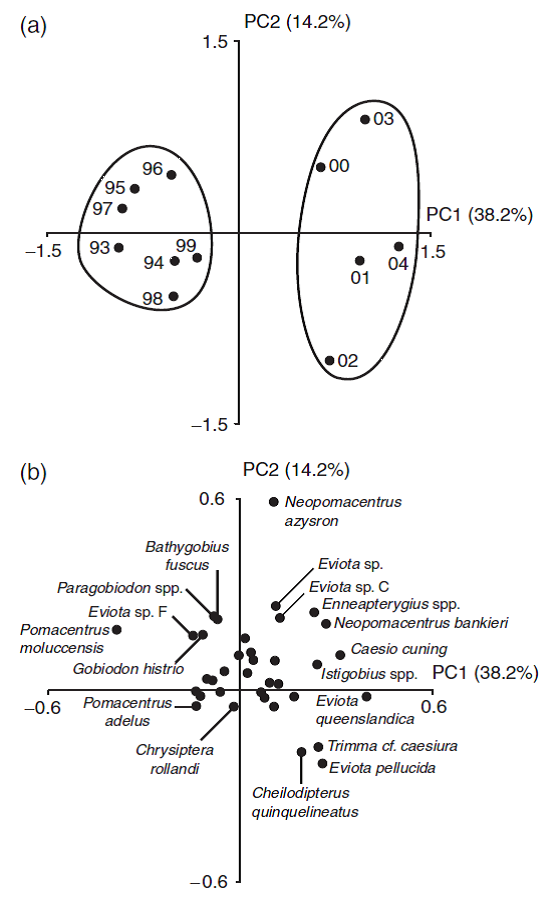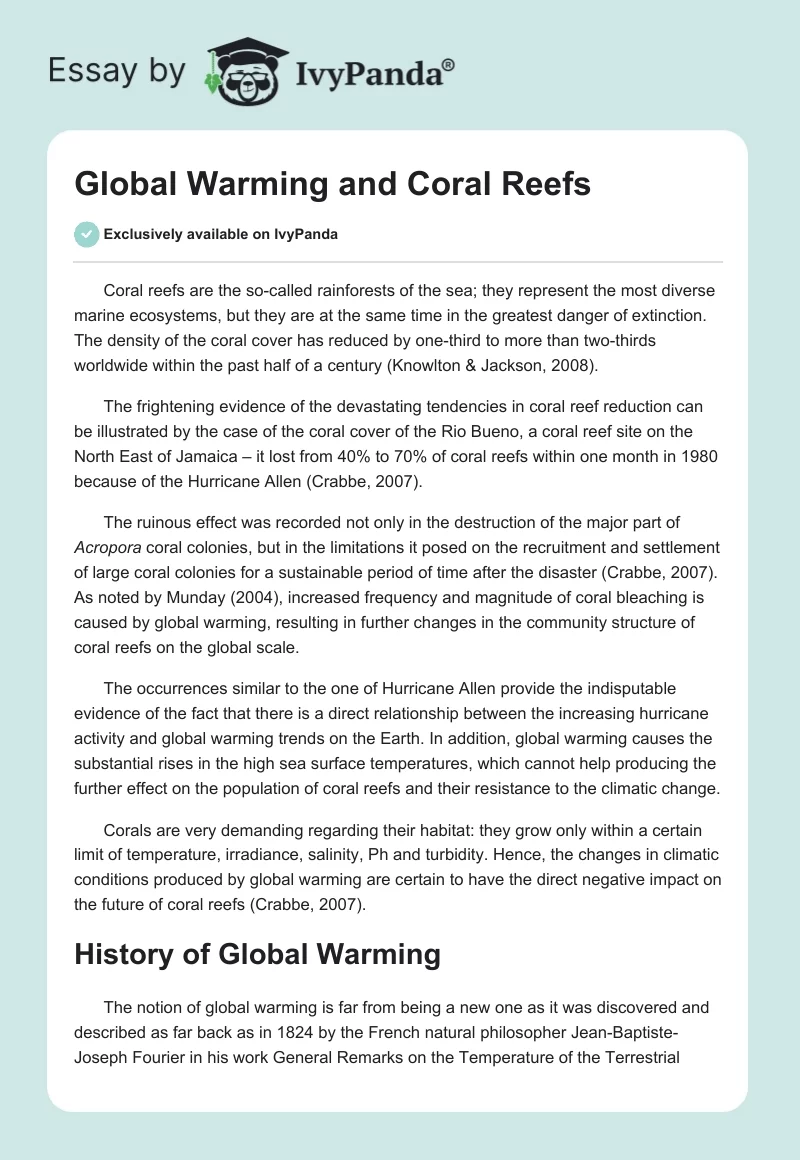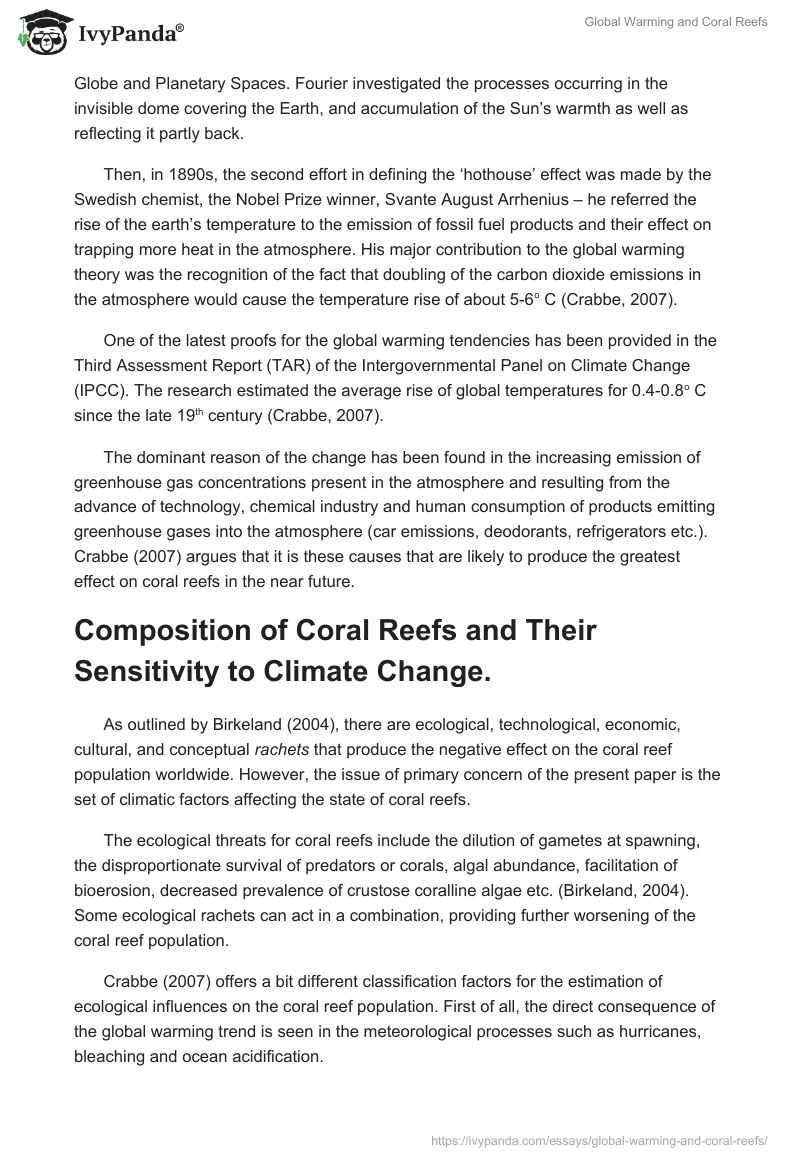Coral reefs are the so-called rainforests of the sea; they represent the most diverse marine ecosystems, but they are at the same time in the greatest danger of extinction. The density of the coral cover has reduced by one-third to more than two-thirds worldwide within the past half of a century (Knowlton & Jackson, 2008).
The frightening evidence of the devastating tendencies in coral reef reduction can be illustrated by the case of the coral cover of the Rio Bueno, a coral reef site on the North East of Jamaica – it lost from 40% to 70% of coral reefs within one month in 1980 because of the Hurricane Allen (Crabbe, 2007).
The ruinous effect was recorded not only in the destruction of the major part of Acropora coral colonies, but in the limitations it posed on the recruitment and settlement of large coral colonies for a sustainable period of time after the disaster (Crabbe, 2007). As noted by Munday (2004), increased frequency and magnitude of coral bleaching is caused by global warming, resulting in further changes in the community structure of coral reefs on the global scale.
The occurrences similar to the one of Hurricane Allen provide the indisputable evidence of the fact that there is a direct relationship between the increasing hurricane activity and global warming trends on the Earth. In addition, global warming causes the substantial rises in the high sea surface temperatures, which cannot help producing the further effect on the population of coral reefs and their resistance to the climatic change.
Corals are very demanding regarding their habitat: they grow only within a certain limit of temperature, irradiance, salinity, Ph and turbidity. Hence, the changes in climatic conditions produced by global warming are certain to have the direct negative impact on the future of coral reefs (Crabbe, 2007).
History of Global Warming
The notion of global warming is far from being a new one as it was discovered and described as far back as in 1824 by the French natural philosopher Jean-Baptiste-Joseph Fourier in his work General Remarks on the Temperature of the Terrestrial Globe and Planetary Spaces. Fourier investigated the processes occurring in the invisible dome covering the Earth, and accumulation of the Sun’s warmth as well as reflecting it partly back.
Then, in 1890s, the second effort in defining the ‘hothouse’ effect was made by the Swedish chemist, the Nobel Prize winner, Svante August Arrhenius – he referred the rise of the earth’s temperature to the emission of fossil fuel products and their effect on trapping more heat in the atmosphere. His major contribution to the global warming theory was the recognition of the fact that doubling of the carbon dioxide emissions in the atmosphere would cause the temperature rise of about 5-6o C (Crabbe, 2007).
One of the latest proofs for the global warming tendencies has been provided in the Third Assessment Report (TAR) of the Intergovernmental Panel on Climate Change (IPCC). The research estimated the average rise of global temperatures for 0.4-0.8o C since the late 19th century (Crabbe, 2007).
The dominant reason of the change has been found in the increasing emission of greenhouse gas concentrations present in the atmosphere and resulting from the advance of technology, chemical industry and human consumption of products emitting greenhouse gases into the atmosphere (car emissions, deodorants, refrigerators etc.). Crabbe (2007) argues that it is these causes that are likely to produce the greatest effect on coral reefs in the near future.
Composition of Coral Reefs and Their Sensitivity to Climate Change.
As outlined by Birkeland (2004), there are ecological, technological, economic, cultural, and conceptual rachets that produce the negative effect on the coral reef population worldwide. However, the issue of primary concern of the present paper is the set of climatic factors affecting the state of coral reefs.
The ecological threats for coral reefs include the dilution of gametes at spawning, the disproportionate survival of predators or corals, algal abundance, facilitation of bioerosion, decreased prevalence of crustose coralline algae etc. (Birkeland, 2004). Some ecological rachets can act in a combination, providing further worsening of the coral reef population.
Crabbe (2007) offers a bit different classification factors for the estimation of ecological influences on the coral reef population. First of all, the direct consequence of the global warming trend is seen in the meteorological processes such as hurricanes, bleaching and ocean acidification.
The effects these processes have on the coral reefs are closely connected with the composition of coral reefs and their life cycle. Corals responsible for building reefs are Scleractinia; they contain zooxanthellae that represent dinoflagellate symbiotic algae (Crabbe, 2007). Zooxanthellae provide photosynthetic carbon and provide corals with sufficient energy in exchange for protection and access to light. The zooxanthellae are the major issue in bleaching:
“Most of the pigmentation in corals is within the zooxanthellae. Coral bleaching is caused by corals losing their zooxanthellae. The coral appears white, or bleached, due to the calcium carbonate coral skeleton showing through the translucent living tissue” (Crabbe, 2007, p. 25).
The effect can be aggravated by raising irradiance, causing corals’ death because of intense bleaching (Crabbe, 2007). The overall conclusion made by researchers is that corals are extremely sensitive to temperature fluctuations, and global warming trends are truly able to provide the large-scale destructive effect on large populations of reefs.
The State of Modern Coral Reef Crisis and Conservation Programs Employed to Face It
There is a great body of evidence on the modern coral reef crisis obvious in the majority of traditional habitats thereof. Multiple studies reflect on the tempos of devastation and possible reasons for those destructive trends.
Thus, for example, the study by Bellwood, Hoey, Ackerman and Depczynski (2006) was dedicated to the 12-year study of the leeward reef slope of Orpheus Island in the central Great Barrier Reef. The research revealed the unexpected vulnerability of coral fish to the destruction of the coral reef habitat, and the 75% morality of the coral reef site (Acropora and Montipora) within the 12 years of investigation caused the disappearance of reef fishes in that site.
This troubling evidence shows the close connection between the distribution of coral reefs and reef fish; the implications of the destructive processes in reefs may cause serious problems for fishing and diversity in certain coastal areas. The statistic results derived in the process of the study by Bellwood et al. (2006) are shown on Figure 1.
Another evidence of the coral reef crisis was provided by Greenstein and Pandolf (2008) – the authors conducted a comparative historical study of coral reef structures in the Western Australia in the Late Pleistocene period and in the modern times. The authors concluded that the coral reefs have surely responded to the climatic change, in particular they contracted North along the coast. More than that, they are likely to continue changing their location in response to further climate changes (Greenstein & Pandolf, 2008).
The study of Munday (2004) was dedicated to other issues concerning the distribution of coral reefs and their future on the background of global warming: the author investigated the site of Kimbe Bay and found out that the decline in Acropora reduced by 58.9% for six years of the study, with coral-dwelling gobies reduced by 59.4% (Munday, 2004).
However, the outer-bay reefs did not reveal much change, which allowed the researcher to make conclusions on the increased impact of the human activities on the population of mid-bay and inner-bay coral reefs.

Figure 1. A shift in structure of coral fish communities in response to the diminishing distribution of coral reefs.
From: Bellwood et al. (2006), p. 1789.
Nowadays NGOs and government agencies are committing much effort to reversing the decline in coral reefs. There is the International Directory of Coral Reef Organizations that monitors the international organizations and their activities on the coral reef preservation and restoration; it has provided the list of 691 organizations and 451 NGOs that worked on the problem in 2004 (Birkeland, 2004). 1998 was marked by the substantial effort from the side of the US government on the restoration of coral reefs –
“President Clinton’s Executive Order 13089 established the US Coral Reef Task Force, cochaired by the secretary of commerce and the secretary of the interior and composed of the heads of 11 federal agencies, the governors of 7 states and territories, and the presidents of the Federated States of Micronesia, the Republic of Palau, and the Republic of the Marshall Islands” (Birkeland, 2004, p. 1021).
The activities have indicated some progress in the area of restoration and conservation: Knowlton and Jackson (2008) indicate that there is an urgent necessity to establish such areas as the newly zoned Great Barrier Reef and the Northwestern Hawaiian Islands to assess the reef’s potential of recovery. The task should be entrusted to the developed countries possessing the financial resources and intelligence potential to adopt a comprehensive, effective approach to the issue.
Conclusion: Saving Coral Reefs through Public Awareness.
It is evident nowadays that tremendous effort is allocated by the worldwide community to save the coral reef population, to stop their reduction tempos and to restore the lost areas. According to Birkeland (2004), the 2004 statistical information listed 691 organizations dedicated to saving coral reefs, with nearly $100 million allocated to their protection.
However, the pace of negative change is not slowing down, and there is hardly any improvement in the ecological situation concerning coral reefs observed. The issue has been brought to the forefront of scientific discussion, and a set of conclusions have been arrived at by researchers in the field.
The problems with assessing the condition of reefs have been detected as the main source of discrepancies and lack of efficient information on the improvement achieved.
As Knowlton and Jackson (2008) note, there are various approaches to assessing coral reefs. Observations among unpopulated and populated areas give a deeper insight into the current processes of degradation and ways to resolve the problem (Knowlton & Jackson, 2008). There are resources for both observing the consequences of the human impact on the coral reef population and trends of recovery in already affected and conserved areas, giving numerous opportunities for assessing the response of coral reefs to the global change.
The conclusions that have been made on the issue so far clearly indicate that the climate change will continue to alter coral reefs since they are the disturbance-adapted ecosystems responding to the shifting steady-state processes in the nature (Crabbe, 2007).
However, the climate change is considered a non-steady-state change, so the future of coral reef outcomes on the background of the continuing global warming is still not clear. The only evident fact is that in case of reef survival for the next 50-100 years and the reduction of additional stressors including the intensity of the human impact on the marine life, there is a high probability for their restoration and adaptation (Crabbe, 2007).
Nevertheless, it is clear that the task of coral reef survival is not solely the responsibility of the ecosystem itself, and not the enactment of internal adaptation mechanisms. The humanity ought to recognize the necessity of their active intrusion in the process of conservation and restoration of coral reef reserves on the Earth.
Birkeland (2004) outlines the major ways for human beings to participate in the process constructively: the external effects such as sedimentation, eutrophication, and chemical pollution still are human-made factors of coral reef degeneration. The global increase of population and economic demand for sea products plays the dominant role in coral reef destruction as well. Hence, people’s management is seen as the main task for the enhancement of marine environment resources (Birkeland, 2004).
The most effective tool for human management is seen in the restoration of the responsibility and awareness concepts. The problem is that many people do not perceive ecological problems as the immediate consequence of their activities, causing further resource depletion (Burkeland, 2004).
Consequently, there is much to take from the islanders’ attitude to marine life on the way to saving coral reefs: people have to develop proactive interventions directed at prevention; they should deal with ultimate and proximate causes of coral reef decline; they should promote responsible human behavior (Birkeland, 2004). The large-scale effect is awaited from those measures as a way to reducing the human impact on the coral reefs t minimum and to direct the effort to minimizing the global change effects as well.


